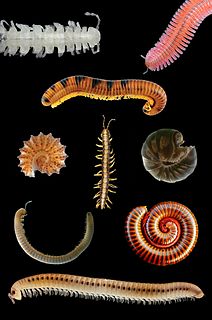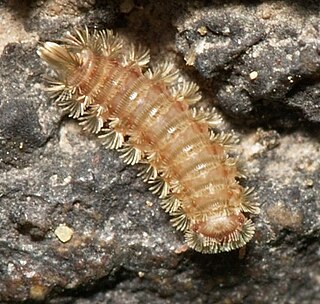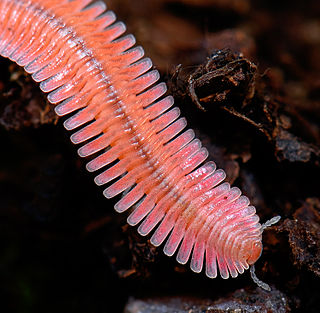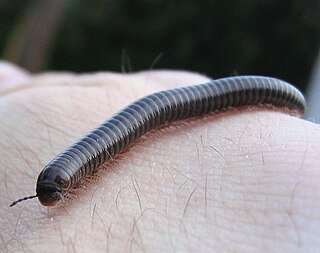
Millipedes are a group of arthropods that are characterised by having two pairs of jointed legs on most body segments; they are known scientifically as the class Diplopoda, the name being derived from this feature. Each double-legged segment is a result of two single segments fused together. Most millipedes have very elongated cylindrical or flattened bodies with more than 20 segments, while pill millipedes are shorter and can roll into a ball. Although the name "millipede" derives from the Latin for "thousand feet", no known species has 1,000; the record of 750 legs belongs to Illacme plenipes. There are approximately 12,000 named species classified into 16 orders and around 140 families, making Diplopoda the largest class of myriapods, an arthropod group which also includes centipedes and other multi-legged creatures.

Pill millipedes are any members of two living orders of millipedes, often grouped together into a single superorder, Oniscomorpha. The name Oniscomorpha refers to the millipedes' resemblance to certain woodlice (Oniscidea), also called pillbugs or "roly-polies". However, millipedes and woodlice are not closely related ; rather, this is a case of convergent evolution.

Desmoxytes, whose species are commonly known as the dragon millipedes, is a genus of millipede of the family Paradoxosomatidae found in southeast Asia. The genus was described by Ralph Vary Chamberlin in 1923 and reviewed by Sergei Golovatch and Henrik Enghoff in 1994. At least twenty-nine species are known from southeastern China to Myanmar, Thailand, and Vietnam. One species, D. planata, has also been observed in Sri Lanka, the Andaman Islands, Seychelles, Java, Great Coco Island, and Fiji; however, this species has expanded its range by being transported through human activity. Several species have only recently been discovered and some have yet to be officially described.

Sphaerotheriida is an order of millipedes in the infraclass Pentazonia, sometimes known as giant pill millipedes. They inhabit Southern Africa, Madagascar, South and Southeast Asia, Australia and New Zealand. Like the Northern Hemisphere pill millipedes of the order Glomerida, these millipedes can roll into a ball when disturbed. When they are rolled-up, most sphaerotheriidans reach a maximum size of a cherry or golf ball, but some species from Madagascar can even reach the size of an orange. When rolled-up, predators are unable to unravel giant pill millipedes since the margins of their second and last dorsal plates fit perfectly into one another, creating a sealed ball. A few giant pill millipede species are able to produce sound, the only millipedes known to do this. This order of millipedes is also unique in that some African species are used for medicinal purposes.

Sphaeromimus, or the chirping giant pill millipedes, is a genus of giant pill millipedes endemic to southeastern Madagascar. Though described in 1902, the genus was up to 2005 known from a single male specimen, whose appearance was so unusual that the authors suspected a mislabeled giant pill-millipede from India. Their unusual and distinct morphology includes well-developed stridulation organs, probably as devices for courtship. These are the male ‘harp’ and the female ‘washboard’, which contain more stridulation ribs than in other members of the order Sphaerotheriida. They have a closer affinity with the Indian genus Arthrosphaera than to other Malagasy genera, though all belong to the Arthrosphaeridae.

Brachyiulus is a genus of millipedes, containing around eight species, most of which live in the Mediterranean Basin of Europe and Asia. The species B. pusillus has been introduced widely around the world

Julida is an order of millipedes. Members are mostly small and cylindrical, typically ranging from 10–120 millimetres (0.39–4.72 in) in length. Eyes may be present or absent, and in mature males of many species, the first pair of legs is modified into hook-like structures. Additionally, both pairs of legs on the 7th body segment of males are modified into gonopods.

Polyxenida is an order of millipedes readily distinguished by a unique body plan consisting of a soft, non-calcified body ornamented with tufts of bristles – traits that have inspired the common names "bristly millipedes" or "pincushion millipedes". There are at least 86 species in four families worldwide, and are the only living members of the subclass Penicillata.

Glomeridesmida is an order of millipedes in the infraclass Pentazonia containing 2 families and at least 31 species. Glomeridesmida is the only living order of the superorder Limacomorpha. Glomeridesmidans are small and somewhat flattened, possess 22 body segments, and unlike other orders of Pentazonia, are unable to roll into a ball. Ocelli (eyes) are absent. Glomeridesmidans occur in the New World Tropics, Southeast Asia, India, and Oceania. Two species are known cave-dwellers, and, like other troglomorphic animals are translucent from loss of pigment. The five known species of Termitodesmus have a commensal relationship with termites.

Polyxenus lagurus, known as the bristly millipede is a species of millipede found in many areas of Europe and North America. It is covered with detachable bristles that have the ability to entangle ants and spiders that attack the animal.

Platydesmida is an order of millipedes containing two families and over 60 species. Some species practice paternal care, in which males guard the eggs.

Richard Lawrence Hoffman was an American zoologist known as an international expert on millipedes, and a leading authority on the natural history of Virginia and the Appalachian Mountains. He was a biology professor at Virginia's Radford College for almost thirty years, and curator of invertebrates at the Virginia Museum of Natural History for another twenty years. He co-founded the Virginia Natural History Society, described over 400 species of millipedes, and produced more than 480 scientific publications. He is commemorated in the scientific and/or common names of over 30 animal species, including the valley and ridge salamander and Hoffman's dwarf centipede.

Callipodida is an order of millipedes containing around 130 species, many characterized by crests or ridges.

Chordeumatida is a large order of millipedes containing some 1200 species with a nearly worldwide distribution. They possess around 30 body segments and reach about 25 mm (0.98 in) in length.

Stemmiulida is an order of millipedes consisting of approximately 130 species, reaching up to 50 mm in length. It contains a single family, Stemmiulidae.
Andrognathidae is a family of millipede in the order Platydesmida. There are about 17 genera and more than 30 described species in Andrognathidae.
Platydesmidae is a family of millipede in the order Platydesmida. There are at least 2 genera and more than 30 described species in Platydesmidae.

Casimir Albrecht Willem Jeekel (1922–2010) was a Dutch myriapodologist and entomologist known for his major contributions to the taxonomy of millipedes. His 1971 monograph Nomenclator Generum et Familiarum Diplopodorum is credited as launching the "modern era" of millipede taxonomy, and has been considered the "most important single work ever published on the Diplopoda". He served as director of the Zoological Museum Amsterdam, and authored over 150 works on the taxonomy of millipedes and other myriapods.

Desmoxytes planata, is a species of millipedes in the family Paradoxosomatidae. It is a pantropical species with a vast distribution due to human interference in transportation. It is native to Andaman Islands and introduced to Thailand, the Seychelles, Java, Sri Lanka, Fiji and probably in Malay Peninsula.

Cylindroiulus caeruleocinctus is a species of millipede in the family Julidae.


















